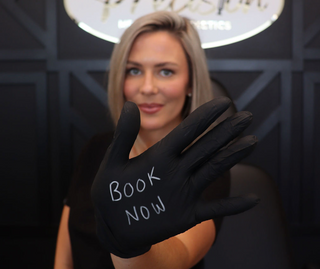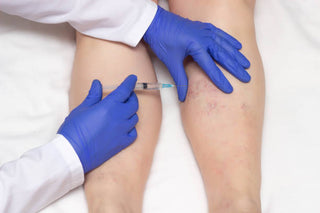
sclerotherapy
KEY PURPOSE
Improves the appearance of varicose and spider veins and alleviates symptoms such as pain, swelling, and heaviness in the legs.
longevity
The results of sclerotherapy can last for several years, often 3 to 5 years, though some patients may need follow-up treatments if new veins appear or if the original condition recurs.
APPOINTMENT TIME
30-60 minutes (depending on number of lesions being treated).

WHAT IS SCLEROTHERAPY?
Sclerotherapy is used to treat varicose veins and spider veins by injecting a sclerosant solution into the affected veins. This solution causes the veins to collapse and seal shut, preventing blood from flowing through them. Over time, the body absorbs the treated veins, and they become less visible or disappear altogether.
POST TREATMENT CARE
Post-treatment care is an important part of ensuring the best results from sclerotherapy and minimizing potential side effects. While the procedure itself is minimally invasive, following the aftercare instructions is essential for a smooth recovery and long-lasting results. Here's a general guide to post-treatment care for sclerotherapy:
1. Wear Compression Stockings
- Duration: Your provider will likely recommend wearing compression stockings for several days to weeks after the procedure. The typical recommendation is to wear them for 24 hours a day for the first 2-3 days, and then you can wear them during the day for up to 1-2 weeks after that.
- Purpose: Compression stockings help improve circulation, reduce swelling, and prevent the blood from pooling in the treated veins. They also promote healing and reduce the risk of complications like blood clots.
2. Avoid Prolonged Standing or Sitting
- For the first 24 to 48 hours, try to avoid standing or sitting for long periods. Regular movement and walking can help improve circulation and prevent complications.
- If you have a sedentary job, take breaks to walk around every 30 minutes to 1 hour.
3. Engage in Light Activity
- Light exercise, such as walking, is encouraged immediately after the procedure and can help improve blood flow.
- Avoid vigorous exercise, like running, aerobics, or weightlifting, for about 1 to 2 weeks after treatment to avoid putting pressure on the treated veins.
4. Avoid Hot Baths, Saunas, and Hot Tubs
- Heat can cause blood vessels to dilate, potentially interfering with the healing process. Avoid hot showers, baths, saunas, and hot tubs for at least 48 hours after the procedure.
- Warm showers are fine, but avoid extremely hot water.
5. Don’t Massage or Rub the Treated Areas
- Avoid rubbing or massaging the treated veins as this could affect the effectiveness of the treatment or cause irritation.
- If you notice tenderness or lumps at the injection sites, your provider may recommend gentle massaging to help break up any blood clots, but this should only be done under guidance.
6. Elevate Your Legs
- Elevating your legs for about 15-30 minutes a few times a day (especially during the first 48 hours) can help reduce swelling and discomfort.
- Aim to elevate your legs above the level of your heart to encourage proper blood flow.
7. Monitor for Side Effects
- Bruising: Some bruising is normal and should fade within a few weeks. If bruising is extensive or painful, consult your doctor.
- Swelling: Mild swelling or puffiness is common, but if it becomes severe or persists for more than a few weeks, contact your provider.
- Cramping or Itching: Temporary cramping or itching may occur around the treated veins but typically resolves on its own.
8. Follow-Up Appointments
- Your provider will likely schedule a follow-up appointment a few weeks after treatment to evaluate the progress and assess the treated veins. Additional sessions may be needed to treat remaining veins or any new ones that appear.
9. Avoid Sun Exposure
- Direct sun exposure to the treated area can increase the risk of hyperpigmentation (skin darkening). It’s a good idea to wear sunscreen on the treated areas if you need to be outside for extended periods.
10. Avoid Alcohol
- It’s advisable to avoid alcohol for 24-48 hours after sclerotherapy because it can increase the risk of swelling and bruising. Alcohol can also interfere with blood circulation and healing.
11. Pain Management
- Most people experience mild soreness or cramping after sclerotherapy, which can be managed with over-the-counter pain relievers, such as acetaminophen or ibuprofen. Be sure to follow the dosage instructions on the label.
- If you have severe pain or other concerning symptoms, contact your healthcare provider.
12. Avoid Smoking
- Smoking can impair circulation and delay healing, so it’s best to avoid it during the recovery period.
Sclerotherapy Pricing
$250 per session.
